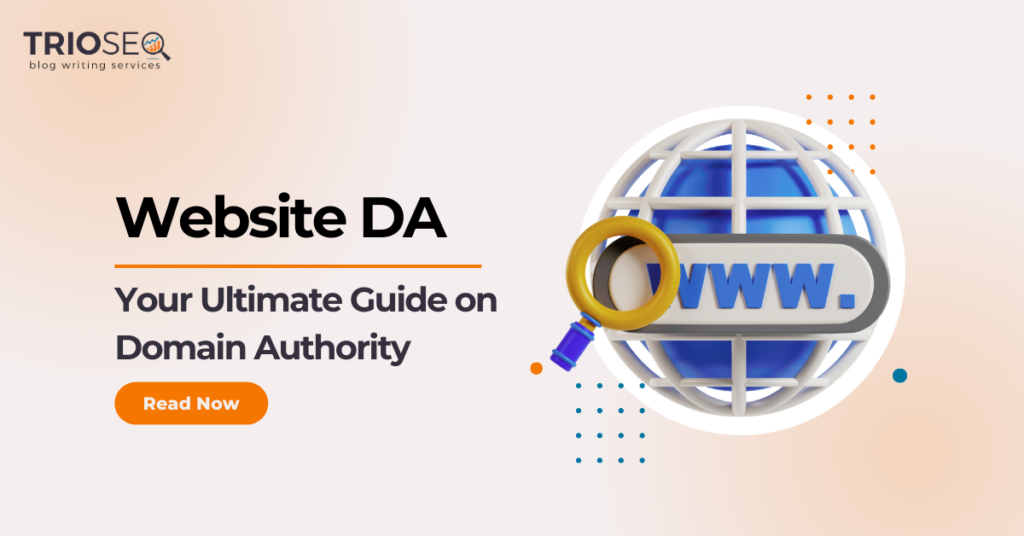Blogging DA or Domain Authority is a phrase that might make you scratch your head if the world of SEO does not absorb you. But don’t worry, we’ve got you covered!
This comprehensive guide will simplify everything about domain authority in blogging.
Let’s get started!
What is Domain Authority (DA)?
Domain authority (DA), created by SEO software company Moz, is a ranking score between 1 and 100 that predicts a website’s ability to rank on search engine results pages (SERPs). A higher DA indicates a better chance of securing a top spot in SERP rankings, significantly boosting your site’s visibility.
Contrary to what the name might suggest, DA is not exclusive to blogs; it applies to all websites, whether commercial or casual. Much like a credit score in finance, your DA score reflects the credibility and relevance of your site in your specific industry or sector, influencing how search engines prioritize your site in rankings.
Understanding and effectively leveraging DA is vital for anyone keen on improving their online presence. It’s a fundamental concept in SEO circles, showcasing your site’s potential ranking power on platforms like Google and guiding your strategy to enhance visibility and organic traffic.
Concisely stated:
- Domain Authority predicts how well a website will rank on SERPs.
- It ranges from 1 to 100; higher scores correspond with better organizing ability.
- Developed by Moz; used widely across SEO and digital marketing spheres.
- Serves as an instrumental factor when analyzing blog performance compared to competitors.

How is Domain Authority Calculated?
Firstly, let’s start by understanding whose tool we are discussing.
In its computation, Moz uses over 40 different signals for the domain authority score. This set of signs consists of various aspects intrinsic to your website, such as the quality of content, social signals (like retweets or likes on Facebook), and search engine friendliness.
Moz links these interconnected factors with a vast database from Google’s search engine results page (SERP). Using machine learning algorithms, they make an accurate assessment that mirrors how Google ranks websites.
To add more color, here are some primary factors contributing to a site’s domain authority:
- Linking Root Domains: This refers to the number of unique domains linking to your blog or website. Having numerous diverse sources providing backlinks enhances your site’s perceived credibility or ‘authority.’
- Backlink Profile Quality: Although having many links directed toward your site can be beneficial, their quality carries significant weight, too. Your DA score improves if authoritative and highly regarded sites link back to you.
- Content Quality: High-quality content attracts visitors and prompts them to share or link it with others’ interactions, which can significantly influence ranking algorithms.
- Search Engine Friendliness: Technical SEO parameters like URL structure, XML sitemap availability, and navigation ease also count towards computing your score.
Domain authority’s comparative nature makes it remarkable- it functions best when assessing competition between websites or tracking records against industry standards rather than solely looking at ‘good’ or ‘bad’ scores.
Simply put, no specific consistency guarantees success since the methodology changes following variations in Google Algorithms; however, being atop these areas certainly aids in maximizing your blog DA.

Does Domain Authority Matter?
Yes, domain authority does matter. Understanding why may require comprehending its relevance in the grand scheme of Internet marketing.
First and foremost, it is essential to note that domain authority acts as an effective forecasting tool for site ranking on SERPs. Though it isn’t a direct factor incorporated by search engines when determining SERP rankings, it has been observed to correlate with these rankings. As a site’s DA climbs higher, a notable improvement in the website’s SERP ranking is often witnessed.
Furthermore, it is an excellent yardstick for benchmarking your websites against competitors’, offering valuable insights into where you stand in the competitive landscape. By identifying gaps between your own and competitor blogs’ DAs, efforts can be strategically concentrated on improving areas that need to catch up.
Finally, yet importantly, domain authority turns out invaluable during link-building processes. When deciding which sites to establish backlinks from or partner with for guest blogging arrangements, etc., high-DA websites prove more beneficial and provide more excellent SEO value. Although DA can be artificially inflated through black hat SEO efforts, it’s still a good gauge used by many.
While Domain Authority (DA) is essential for improving visibility and reach, it shouldn’t be the sole focus. It’s necessary also to prioritize content quality and user experience. Consider DA one critical component in your broader SEO strategy, not the ultimate determinant of digital marketing success.

What is a Good Domain Authority?
When you stand on the brink of improving your blogging DA, one question that looms large is, ‘What exactly is a good domain authority?’
Understanding this can distinguish between spearheading an effective SEO strategy and navigating dark waters.
As mentioned, DA shadows a scoring system from 1 to 100. Like our educational grading system, higher scores signify stronger signals for search engines.
However, reaching closer to a hundred is a challenging task, and it is supposed to be your end goal. Instead, aim towards achieving more than your competitors within a specific industry niche.
Here are a few examples to showcase this:
- A very small or new blog might generally have a DA lower than 20.
- A medium-sized blog gradually growing with consistent content updates could reach up to DA 30 – 40.
- More prominent blogs with strong inbound links profiles sit proudly at DA 50+ range.
Remember, increasing your domain authority (DA) is not like aiming for higher school grades but more like improving your time in a race. Just as in racing, where every second shaved off your personal best is a victory, in the digital space, even minor improvements in your DA score can be seen as a win.
Think of it as a continuous race where persistent effort, similar to a runner’s regular training, is key to progress. So, don’t be disheartened by minor increments in your DA; even small advances demonstrate better SEO health for your blog.
In short, instead of stressing over what constitutes a ‘good’ or ‘bad’ DA score, aim to enhance your score steadily, celebrating each improvement as a step toward success.

How to Increase Domain Authority
In the world of blogging DA, increasing your domain authority holds immense significance for a better ranking on search engine results. However, it requires more than some simple hocus-pocus but a systematic approach and undeviating attention to specific details.
Firstly, you need to fine-tune your technical SEO. A well-structured website eases search engines’ indexing process, potentially boosting your score. Ensure that any issues related to URL structure, navigability, site map, and robots.txt are aptly addressed – remember, we’re looking for top-notch quality over quantity here.
Secondly, keep in mind that Content is King. High-quality content invites organic shares and natural benefits from backlinks. Therefore, go beyond just delivering information – aim at adding value.
Thirdly, robust internal linking facilitates user navigation and helps distribute value evenly across your website’s pages, assisting search engine crawlers in better understanding the overall layout.
Finally, yet importantly, disavow wrong links as they can cause more harm than good, as Google penalizes sites with suspicious inbound links.
How Long Does it Take to Increase Domain Authority?
Many bloggers often express concerns about how long domain authority takes to increase. You need to know that there isn’t a concrete answer—it varies!
The pace at which you enhance your domain authority hangs upon various factors, such as website age, link profile growth rate, and much more.
However, under most circumstances, improving one’s domain authority could require somewhere between four months to a year of consistent effort — this depends on where you’re starting from. If your blog DA is on the lower end, don’t lose heart!
Endurance is critical here – stay patient while consistently following all the right strategies. SEO is not an overnight process, but with time and dedication, you’ll notice a significant rise in your blog’s domain authority score. Remember – the journey of a thousand miles begins with one step, and the same applies to increasing your blogging DA.

Domain Authority vs. Page Authority
In our journey through the wonderful world of SEO, we’ve come across two terms more often than not: Domain Authority (DA) and Page Authority (PA).
The interplay between these two facets of website management may seem complex at first glance because both are essential to boosting your blog’s DA.
Careful, though! While they might appear similar, each one serves a different purpose.
Let’s dive into this further.
To refresh your memory: Domain authority indicates how well a website will rank on search engine results pages (SERPs), derived from numerous data points such as linking domains, number of total links, and MozRank.
On the other hand, Page Authority, although similar in calculation methodology, evaluates individual web pages instead of whole websites.
In layman’s terms, while domain authority offers a bird’s eye view of your entire digital property’s potential performance in SERPs, page authority provides insights into how singular pages would fare.
Here are crucial differences to keep in mind:
- Domain Authority looks at your entire domain from a ‘big picture’ perspective.
- Page Authority focuses exclusively on single webpage performance.
One key takeaway should be that improving either metric isn’t about chasing numbers but understanding what influences them: quality content and firm backlink profiles play pivotal roles for both.
Does one affect the other?
Well yes!
Suppose any of your pages have high PA scores thanks to excellent SEO practices and robust link strategies. Those efforts also positively impact DA scores by enriching your site’s overall strength and reputation.

Domain Rating vs. Domain Authority
Regarding blogging DA, two key terminologies often surface: Domain Authority (DA) and Domain Rating (DR). Both metrics play a significant role in SEO strategies, but they hail from different providers and function on varying algorithms.
Understanding Domain Authority
To start with, let’s revisit the concept of domain authority. As previously established, this metric is set by Moz to predict how well your website would rank on search engine result pages (SERPs), depending mainly upon link data. It represents an accumulative score out of 100, which increases along with the likelihood of ranking higher.
Understanding Domain Rating
On the other hand, you have ‘Domain Rating‘ – a similar proprietary metric developed by Ahrefs. Encapsulating a spectrum from zero to a hundred points, this score shows the combined strength of all backlinks leading back to a website, weighing more on quantity than quality.
Contrasting The Two Metrics
Now that we’ve sketched brief definitions of both parameters side-by-side, let’s dig into their differences:
- Firstly, their sources vary: Moz emerges as the creator behind DA, whereas Ahrefs presents DR.
- Secondly, while both scores come packaged within ranges scaling up to a hundred points, DA stresses more on the qualitative aspects – contemplating even features like complex linking profiles and spam scores under its algorithm’s umbrella.
So remember, when thinking about Moz domain authority vs. Ahrefs domain rating, it’s not about choosing one over another but understanding these metrics so you can run integrated checks, ensuring comprehensive success!
How Often is Ahrefs Domain Authority Updated?
The frequency with which Ahrefs updates its database has a fundamental influence over your DR. The professionals at Ahrefs have revealed that their system refreshes the index approximately every 15 minutes. In contrast, the leading rating update happens roughly once per month. It implies that significant changes in your blog’s backlink profile will reflect on your ‘Domain Rating’ in a nearly real-time manner – adding velocity to feedback for implemented strategies.
How Often Does Moz Update Domain Authority?
Distinctively, the frequency with which Moz updates its DA metrics varies considerably compared to Ahrefs. As per Moz themselves, their system updates the Link Explorer index and domain authority scores roughly every month. Thus, when you significantly upgrade your link profile, you may have to wait up to a month before seeing it stimulate an increase in your Domain Authority score.
Remember – while metrics like DR and DA give valuable insights into your blog’s power, they’re not directly impacting Google’s ranking algorithms. That’s why we recommend you use these tools for analysis and strategic planning rather than obsessing over increasing the scores alone.

Frequently Asked Questions
Let’s cover some frequently asked questions:
How Do I Find My Domain Authority?
Finding your domain authority is relatively straightforward; it involves no complex steps. Using a tool like Moz’s Link Explorer is one of the most popular methods to determine your site’s DA. Input your website’s URL into their search bar, and Voila! The tool will immediately report your site’s metrics, including its domain authority score. Alternatively, Ahrefs’ Website “Authority” Checker will do the same.
Is Domain Authority a Ranking Factor?
While understanding what domain authority is, many bloggers often confuse it with being an explicit ranking factor in Google’s algorithm—it isn’t.
However, while Google doesn’t use domain authority directly for rankings, many factors contributing to a higher DA are indeed part of Google’s algorithm.
Elements like link profiles count as significant ranking factors for search engines. Consequently, while having a high domain authority may correlate with better search rankings, they aren’t causative of these ranks.
Why Did My Domain Authority Go Down?
Experiencing a decrease in blog DA might seem problematic initially, but remember – fluctuations can happen.
Several reasons could cause your blogging DA to drop:
- Loss of backlinks: If sites linking to yours removed or changed those links.
- Increased competition: New or existing sites gained more high-quality links faster than yours.
- DA Calculations Updates: SEO tools like Moz regularly update their DA calculations to reflect the current search landscape better, leading to changes in scores.
Why is My Domain Authority So Low?
A low domain authority score might imply something other than an underperforming website. Instead, it’s typically a sign of more room for growth.
You may have a modest DA score if you’re starting with your blog or have limited links pointing toward your site—reasons often synonymous with newer websites.
Nonetheless, this allows you to strategize your approach to increasing domain authority and steadily witness subsequent SEO rankings and traffic enrichments.
Conclusion
Domain Authority (DA) is a critical metric in blogging that goes beyond just being a statistic; it measures your site’s search engine viability. Knowing your DA helps gauge your standing among competitors and directs your efforts to improve it as part of a broader SEO strategy.
Understanding this involves diving deep into metrics like Moz Domain Authority and Ahrefs Domain Rating and discerning the differences and relations between related concepts such as domain rating and page authority.
While aiming for a high DA score is common, there’s no one-size-fits-all “good” score, as it varies across different industries. As you enhance your DA, remember that SEO improvements are gradual.
In conclusion, continuously educating yourself on DA and strategizing is pivotal. With concerted efforts and intelligent strategies, you’re set on a steady growth path. Start your journey towards a higher blogging DA, remembering that understanding leads to optimal actions and desired outcomes.




![Featured Image - Mental Health Content Writing [Best Practices and Ethical Considerations]](https://trioseo.com/wp-content/uploads/2024/05/Mental-Health-Content-Writing-Best-Practices-and-Ethical-Considerations-300x157.png)
![Featured Image - Beginner’s Guide to CBD Content Writing [Tips Included]](https://trioseo.com/wp-content/uploads/2024/05/Beginners-Guide-to-CBD-Content-Writing-Tips-Included-300x157.png)

![Featured Image - [Ultimate Guide] SEO For Tech Companies That Outranks Competitors](https://trioseo.com/wp-content/uploads/2024/04/Ultimate-Guide-SEO-For-Tech-Companies-That-Outranks-Competitors-300x157.png)

![Featured Image - B2B SaaS SEO - Ultimate Guide [Strategy Included]](https://trioseo.com/wp-content/uploads/2024/04/B2B-SaaS-SEO-Ultimate-Guide-Strategy-Included-300x157.png)

